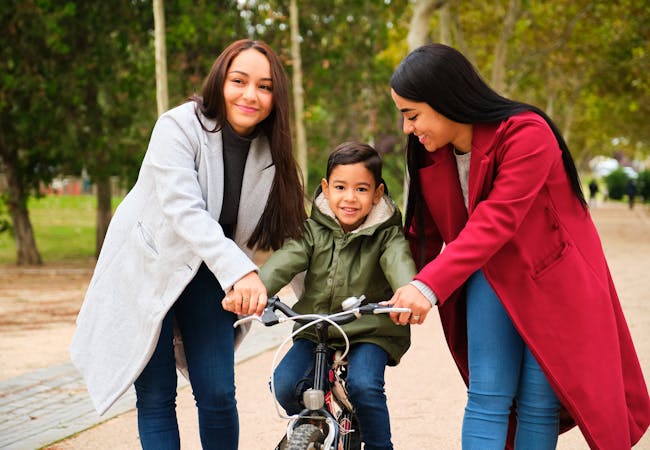For Parents: Healthy Living
Psoriasis is a chronic disease that causes systemic inflammation in the body. There are actions you can take to help your child or teen live a healthy life with psoriasis and reduce their risk of developing comorbidities or related health conditions such as psoriatic arthritis, heart disease, diabetes, and more.
Learn more about psoriatic arthritis and other related health conditions.

Help Your Child Maintain a Treatment Plan
Treating psoriasis helps reduce inflammation and can increase quality of life. Following a treatment plan impacts the disease that prompts plaques to develop and the potentially painful, swollen joints that occur with psoriatic arthritis. To help your child maintain a treatment plan:
Talk with your child about any problems with their treatment
Talk with your child to see if they are having any problems following the prescribed treatment plan from their health care provider, dermatologist, or rheumatologist. Symptoms not improving or flares could signal that your child may have trouble following the treatment plan. Use strategies such as connect-the-dots when applying topicals or calendar apps on phones as reminders to take pills or give injections. You can also use a symptom tracker to help identify triggers, patterns, and how effective the treatment plan may be. When a child uses their treatment appropriately, it is one of the most effective ways to work towards clearing psoriasis or reducing the swelling and pain associated with psoriatic arthritis.
Explore treatment options
There are many treatment options available. This could include changing the dose, adding a new treatment to your child’s current treatment plan, or switching to a different treatment depending on how limited or extensive their disease may be. Ask your child if they prefer a topical, pill, or injection. Discuss what options could work with your child and your child’s health care provider to identify a plan they feel they can follow. Be sure to keep follow-up appointments to help assess progress. Remember that it takes time for treatments to work and not every treatment works for everyone.
Choose Healthy, Well-Balanced Foods for Meals and Snacks
Treatments for psoriasis are not the only action you can take. You can help your child and family learn to make food choices that help your child grow, build strong bones and muscles, and have the energy to move. Eating a balanced diet helps lower the risk of developing related health conditions like heart disease or diabetes.
Choose meals and snacks from the five food groups
Help your child learn to make healthy food choices from the following five food groups for meals and snacks:
- Fresh fruits and vegetables are a great source of vitamins, minerals, and fiber.
- Variety of protein choices such as lean meats, fish, eggs, beans, and unsalted nuts.
- Low-fat or fat-free dairy products such as milk, fortified soy, or other plant-based milk products, yogurt, and cheese.
- Whole grains such as whole wheat bread or pasta, quinoa, brown or wild rice, oats, oatmeal, and popcorn.
Limit food choices high in sugar, salt, and certain types of fats
Limit food choices high in:
- Sugar including those with corn syrup, corn sweetener, and brown sugar as well as sugary drinks and candy.
- Salt can be hidden in sandwich meat, bread, condiments, pizza, canned soups, and other processed foods.
- Saturated fats and trans fats are found in cakes, ice cream, doughnuts, chips, fried foods, sandwiches, burritos, burgers, and more.
Use more whole foods with little processing to help maintain nutrients compared to foods that are more processed. You can also use herbs and spices to help cut down on the amount of salt in your family meals.
Try making fun snacks
Try creating fun snacks that appeal to your child. Instead of snacking on chips and cookies, encourage your child to snack on fruits and vegetables. Here are some snack ideas:
Make an apple sandwich.
- Spread peanut butter or almond butter between two apple slices. An instant apple sandwich!
Veggie dive!
- Choose vegetables in many colors such as slices of cucumbers, yellow or orange peppers, broccoli, carrots, or celery to dip in low-fat ranch dressing or hummus.
By encouraging your child to eat a balanced diet that supports healthy development you may also help to keep your child’s weight in an average range. Children who are overweight or considered obese are more likely to develop psoriasis with the disease being more severe, and they are also at increased risk of developing heart disease, diabetes, and metabolic disease. If your child is overweight, talk with your child’s pediatrician, a registered dietitian, or other health care provider about what changes you can make together as a family.
To learn more request a copy of the NPF Healthy Eating Guide.
Encourage Your Child to Be Physically Active Every Day
In addition to your child making healthy food choices, being physically active every day and limiting screen time will help their body feel good both inside and out. Encourage your child from a young age to find activities they enjoy doing such as playing soccer or baseball, joining a sports team, running, walking, or playing outside. Give your child toys or equipment that promote being active as well as being safe. Involve the family and enjoy activities together –and make what you do fun!
Activity recommendations by age
The Centers for Disease Control and Prevention (CDC) recommends children and adolescents get at least 60 minutes of physical activity every day:
- Children 3–5: Should be active throughout the day
- Children 6–17: Should be active for at least 60 minutes a day, including aerobic, muscle-strengthening, and bone-strengthening activities [1].
What to do if psoriatic arthritis is present
If psoriatic arthritis is present, have your child try activities that are easy on the joints such as swimming, yoga, or Tai Chi. The goal is to move the joints to maintain muscle and joint function and to avoid stiffness. If a physical therapist worked with your child previously, continue to do the stretching and muscle strengthening exercises, but do them together. Always talk with your child’s health care provider before your child starts a new sport or exercise plan.
Talk About Feelings
In addition to the physical impact, psoriasis can also have an emotional impact. Does your child feel embarrassed by their psoriasis? Do they feel alone or afraid? These are all feelings that other children with psoriasis have. Having psoriasis and/or psoriatic arthritis can take an emotional toll and lead to depression. Learn more about the signs and symptoms of the emotional impact.
Encourage your child to be open about their feelings
Having psoriasis and/or psoriatic arthritis can take an emotional toll and lead to depression. Learn more about the signs and symptoms of the emotional impact. Encourage your child to be open about their feelings and symptoms with you so you can help them find a solution whether it is addressing the treatments they use or finding a mental health care professional to address their feelings about having psoriasis.
It’s not their fault
You can help your child learn as much as they can about their disease and to recognize that flares of the disease can happen with stress or illness and it is not their fault. Use a symptom tracker to help identify and discuss potential triggers. Help your child learn to show others who they really are as an individual and not to focus on their skin.
Sleep Matters!
Sleep is important for your child’s overall wellbeing and lack of sleep can impact both physical and mental development. Sleep allows your child’s body to recharge and restore energy.
Impact of not getting enough sleep
Not receiving enough sleep can:
- Impact development and function of the brain.
- Increase the risk of developing depression, anxiety, and stress which is known to trigger psoriasis.
- Impact the ability to focus and follow directions especially in school due to fatigue and feeling tired.
- Increase the risk of developing other health conditions such as obesity, type 2 diabetes, high blood pressure, and mental health issues.
- Weaken the immune system.
Sleep recommendations by age
Children ages 6-12 years need at least 9 to 12 hours of sleep and teens ages 13-18 years need 8 to 10 hours of sleep. [2] If your child’s sleep is often interrupted by pain or movement, talk with their health care provider about how to improve your child’s sleep habits. Download a copy of our Healthy Sleep Guide.
Help Educate School Staff and Peers About Psoriasis
You can help school staff and classmates gain a better understanding and acceptance of your child's psoriasis and psoriatic arthritis by actively engaging in education opportunities. Use resources from NPF to educate school staff, or you and your child can make a presentation about psoriasis to classmates.
Develop a quick response to “What is psoriasis?"
Help your child develop a quick 2-3 sentence response when people ask questions about their psoriasis. Most people want to know what it is, why it happened, and if they can get it too. An example of a potential response could be:
“It’s not a rash, it’s a disease called psoriasis which causes my skin to grow too fast. It’s not contagious so you can’t catch it. It’s something I was born with.”
Help others understand
Having a better understanding of what psoriasis is and that it is not a contagious disease often helps to reduce potential bullying and makes it easier for your child to participate in activities or identify help from school staff or peers when needed. When school staff and classmates know more about the disease, they will have fewer questions and be more accepting. Note: It is possible a 504 Plan may need to be implemented if accommodations need to be made on behalf of your child especially if psoriatic arthritis is present. Find school resources.
Find Support From Others and Continue to Learn
Talk with other parents who have a child with psoriasis and/or psoriatic arthritis and learn what they do to help their child live easier with psoriatic disease. The more you know about psoriasis, the more you will be able to cope and help your child manage their disease.
Talk with another parent who understands
You can find another parent to talk with through the NPF One to One Program. The One to One Program has several trained parent volunteers who know what it’s like to have a child with psoriasis and psoriatic arthritis. They are available to help offer support and their experience but not medical advice.
Continue to learn and stay current
To help keep up-to-date on the latest information, treatments, and research about psoriasis and psoriatic arthritis subscribe to NPF's Advance Weekly Newsletter. You can also read stories about how other people live successfully with psoriasis and psoriatic arthritis.
By using the tips above you can help your child manage their psoriasis and/or psoriatic arthritis to live their life more easily, less bothered by their disease. Such tips will help them develop habits that will help reduce the impact of psoriasis and psoriatic arthritis as they grow older and help them to be more self-assured.
Additional Resources

Patient Navigation Center
Contact the Patient Navigation Center if you need help finding a physician to help your child find an appropriate treatment plan.

Healthy Eating Guide
Learn recommendations based on the latest research and what additional steps you can take to make healthy eating a part of your child’s psoriatic disease management plan.

Connect with Other Parents
Talk to a parent whose child has psoriasis and/or psoriatic arthritis through our One to One program.
References
- “Making Physical Activity Part of a Child’s Life” Centers for Disease Control and Prevention. https://www.cdc.gov/physical-activity-basics/adding-children-adolescents/index.html
- “Recommended Amount of Sleep for Pediatric Populations: A Consensus State of the American Academy of Sleep Medicine” https://aasm.org/resources/pdf/pediatricsleepdurationconsensus.pdf